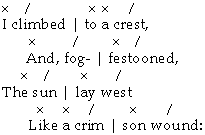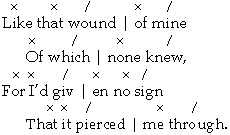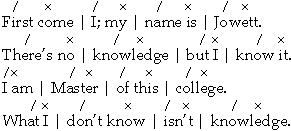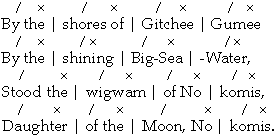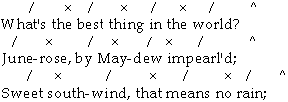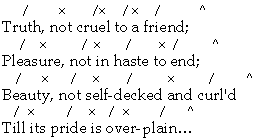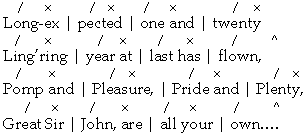Introduction to Meter
TIMOTHY STEELE
![]() nglish-language
poetry is written mostly in iambic meters. “Meter” (from the Greek metron) means “measure” and denotes the rhythmical organization of verse
lines. “Iambic” refers to a specific kind of rhythm that alternates
between relatively lightly stressed syllables and relatively heavily
stressed ones. Because iambic rhythm suits English speech more naturally
and flexibly than other rhythms, it has been the principal mode of English
poetry from the time of Geoffrey Chaucer (14th c.) to the present day.
nglish-language
poetry is written mostly in iambic meters. “Meter” (from the Greek metron) means “measure” and denotes the rhythmical organization of verse
lines. “Iambic” refers to a specific kind of rhythm that alternates
between relatively lightly stressed syllables and relatively heavily
stressed ones. Because iambic rhythm suits English speech more naturally
and flexibly than other rhythms, it has been the principal mode of English
poetry from the time of Geoffrey Chaucer (14th c.) to the present day.
Below are short passages from poems (the final one is actually a complete two-line epigram) that illustrate the chief meters of English verse. All the selections feature iambic rhythm. The lines, however, differ in length. The shortest has two feet and four syllables. The longest has five feet and ten syllables. (A “foot” is the basic rhythmical unit of a verse line; in an iambic line, this unit consists of a metrically unaccented syllable followed by a metrically accented one.) As Robert Frost once remarked, prefacing a proposed collection of his work for younger readers, poets follow “The measured way, … so many feet to the line, seldom less than two or more than five in our language” (Frost: Collected Poems, Prose, and Plays, edited by Richard Poirier and Mark Richardson [New York: Library of America, 1995], 847).
Who knows his will?
Who knows what mood
His hours fulfil?
His griefs conclude?
(J.V. Cunningham, “Meditation on a Memoir,” 1-4)How frightened you were once
—And not so long ago—
When late one night we took
Our pathway homeward through
The churchyard where you saw
Grey gravestones row on row.
(Dick Davis, “Mariam Darbandi,” 1-6)This youth too long has heard the break
Of waters in a land of change.
He goes to see what suns can make
From soil more indurate and strange.
(Louise Bogan, “A Tale,” 1-4)I rang them up while touring Timbuctoo,
Those bosom chums to whom you’re known as Who?
(X. J. Kennedy, “To Someone Who Insisted I Look Up Someone”)
To clarify the structure of these selections, we can scan them. (“Scan” comes from the Latin scandere, “to climb”; the etymology of the word suggests the process of moving up or along, and analyzing step by step, a verse line.) Scanning lines involves dividing them into their component feet and assigning a metrical value to each syllable. A metrically unaccented syllable is conventionally noted with an “x,” a metrically accented syllable with a “/.” Lines are named with reference to their prevailing rhythm and number of feet.
We should bear in mind several points about scansion. First, scansion divides lines according to units of rhythm, not units of sense. Scansion, in other words, treats a line merely and abstractly as a row of syllables. It does not consider the ways in which the syllables are clustered into words, phrases, clauses, or sentences. Hence, though we sometimes find lines in which divisions between feet coincide with divisions between words,
He goes | to see | what suns | can make
we just as often find lines in which they do not. For instance, in the second line of Kennedy’s epigram, “touring” crosses the boundary between the third and fourth feet and “Timbuctoo” crosses the boundary between the fourth and fifth feet:
I rang | them up | while tour <|> ing Tim <|> buctoo
Another point is that the only requirement of an iambic foot is that its second syllable be weightier than its first. The exact degree of difference is, for purposes of scansion and metrical analysis, irrelevant. Hence some iambs may consist of two relatively light syllables (as long as the second still is heavier than the first) and other iambs may consist of two relatively weighty syllables (again, as long as the second still is heavier than the first).
We can make this point clearer by supplementing the conventional two-level notation of scansion with a numerical four-level register, using 4 to stand strong stress, 3 to stand for semi-strong stress, 2 for semi-weak stress, and 1 for weak stress. With this supplementary notation, we can indicate that, though all the feet in the following tetrameter are iambs, the second foot is lighter than the others:
Similarly, we can demonstrate that the first foot in the following iambic trimeter is fairly heavy. (The second foot is perhaps relatively heavy, too.)
A third point—it’s related to and implicit in the second—is that we determine whether a syllable is metrically unaccented or accented by comparing it solely to the other syllable or syllables in the foot in which it appears. We do not weigh it against all the other syllables in the line or the poem. Consequently, a metrically unaccented syllable at one point in a line may actually carry more speech emphasis than a metrically accented syllable at another point. Consider, for example, this line:
Of dead leaves stuck together by the heat
(Frost, “Hyla Brook,” 11)
Here “leaves,” the metrical off-beat of foot two, actually has more speech stress than “by” the metrical beat of foot four:
The line, however, remains conventionally iambic, since the poet maintains the fundamental lighter-to-heavier fluctuation and since the syllables in each individual foot reflect the lighter-to-heavier relationship characteristic of iambs.
As these observations suggest, the fluctuation between lighter and heavier syllables in iambic verse is rarely a uniform ka BOOM, ka BOOM, ka BOOM, ka BOOM, ka BOOM. Instead, the fluctuation involves a much more subtle and fluid lighter-to-heavier movement. Sometimes the difference of stress levels between syllables is great; sometimes it is only slight. And what good poets do, when they write iambic verse, is to maintain the fluctuating pattern while continually modulating it from within. They stick to the basic form, but realize it in ever-varying ways.
It is from this interplay between the unchanging metrical pattern and the many-shaded rhythms of natural speech—this interplay between the steady underlying pulse of the meter and the variable phrases, clauses, and sentences riding over it—that iambic verse draws its vitality and delight.
AN INTERESTING SIDE NOTE
From time to time, we will encounter in iambic verse two adjacent feet whose syllables represent four rising degrees of stress:
Strictly speaking, the analyzed feet remain iambic, since the second syllable in each is stronger than the first. However, because we have a light iamb followed by a heavy one, the overall rise and fall of the line is briefly suspended in favor of continuous ascent.
THE
EFFECT OF VERBAL, GRAMMATICAL,
AND RHETORICAL CONTEXT ON ENGLISH METER
In ancient Greek and Latin prosody, which measures syllable length rather than syllable stress, the metrical nature of syllables can be determined, for the most part, on the basis of phonemics and phonetics. If a syllable has a long vowel or a diphthong, it is long. If it has a short vowel but is “closed” by a consonant, it is also long. Otherwise, it is short. Things are not so simple, however, with our stress-based English meters. We cannot abstractly categorize the metrical values of syllables to the degree that the ancients could, since verbal, grammatical, and rhetorical context can affect stress, especially as it relates to monosyllabic words, in all sorts of ways.
An illuminating instance of the effect of rhetorical context appears in Shakespeare’s comment (Sonnets, 129.13-14) about the destructive consequences of yielding to illicit sexual passion. (Though I shall focus on the first of the lines below, I should mention with regard to the second that, in Shakespeare's time, "heaven" was said as a monosyllable and could be treated metrically as a monosyllable or a disyllable. Hence, though the last line seems for us to have an extra syllable, for Shakespeare it does not.)
All this | the world | well knows | but none | knows well
To shun the heaven that leads men to this hell
Here the third foot of the divided line consists of the adverb “well” plus the verb “knows”; then, two feet later, Shakespeare gives us another foot with the same words, transposed. And, paradoxically, both feet are iambs. Shakespeare initially perceives that everyone knows that lust is wrong, and then sadly adds that such knowledge is not always sufficient to prevent dishonorable conduct:
All this | the world |well knows, | but none | knows well
(Shakespeare’s line also illustrates one advantage of understanding metrical structure. It enables us to hear more readily, accurately, and sensitively than we otherwise could what the poet is saying.)
Another illustrative case—this one involving grammatical rather than rhetorical context—appears in Frost’s description (“The Egg and the Machine,” 5-6) of a railroad-hating man who regrets not having sabotaged some track when he had the chance:
He wished when he had had the track alone
He had attacked it with a club or stone
In
the third foot of the first line of this couplet, “had” changes its metrical
nature because the poet is writing in the past perfect tense. The first
“had” is merely auxiliary, whereas the second “had”—the past participle
of “have”—is the main verb:
Some readers may note that, in the couplet’s second line, the auxiliary “had” occupies a metrical beat, and this results from its verbal context or environment. At this point, “had” is flanked fore and aft by relatively weak syllables—the pronoun “He” and the unaccented syllable of “attacked.” As linguists tells us, it is difficult to say a succession of syllables with exactly the same degree of stress, and when we speak three light syllables in a row, we tend to “promote” the middle one a little. To be sure, the auxiliary “had” doesn’t take as much actual speech stress as the accented second syllable of the main verb “attacked.” But the auxiliary has more stress than its immediate neighbors and therefore takes a metrical beat:
Something similar occurs in the following line, where the relatively light preposition “to” is promoted to a metrical beat as a result of being preceded by the unaccented syllable of “turnip” and followed by the article “the”:
Conversely, a weighty word may be metrically “demoted” if flanked by other weighty words. In the following line, for example, “warm” is a metrical off-beat because it’s preceded the verb “think” and followed by the noun “days”:
THE PRINCIPAL METRICAL VARIATIONS IN IAMBIC VERSE
Historically, there are two main metrical variations in iambic verse. The first involves the “substitution” of a trochee (a foot consisting of a metrically accented syllable followed by a metrically unaccented one) at the beginning of the line:
Trochaic substitutions can also appear elsewhere in the line, though such substitutions are less frequent than those that occur in the first foot. The most common place that these latter substitutions appear is in the third or fourth foot, usually following a pause in sense, which may or may not be marked by punctuation:
The second common variation is the so-called feminine (or “hypermetrical”) ending—the addition or appearance of an extra unaccented syllable at the end of a line:
Now and then, we’ll encounter a line with both a trochaic first foot and a feminine ending:
Roman Jakobson once suggested that these variations evolved because, situated at the beginnings and endings of line, they do not really disrupt the rhythm. At the beginning of the line, there’s generally a grammatical juncture or a pause in movement, and consequently the reader’s ear can assimilate a variation there without too much trouble: no developing pattern of rhythm is broken. Similarly, the extra unaccented syllable at the line end does not interrupt the fluctuating iambic rhythm, but rather just continues it one syllable beyond where it customarily ends.
However these two variations evolved, they have proved of great practical assistance to poets. Many English words of two or more syllables start with a heavy syllable or end with a light one. Though such words can be integrated into the middle of the iambic line, it is useful also to have the option of setting them at the head of the line or at the end of it. The conventions of the trochaic first foot and of the feminine ending allow poets these alternative placements. Consider the following line (115) from Frost’s “Generations of Men”:
Making allowance, making due allowance
This line twice features the fore-stressed disyllabic word “making” and the middle-stressed trisyllabic word “allowance.” The second time “making” appears, it is integrated iambically into the interior of the line; however, the convention of the trochaic first foot lets Frost position the word at the line-beginning as well. When “allowance” first appears, Frost merges it into the iambic rhythm of the line’s interior; but the convention of the feminine ending permits Frost to employ the word at the line-ending, too:
LOOSE IAMBIC
“All that can be done with words is soon told. So also with meters— particularly in our language where there are virtually but two, loose iambic and strict iambic.”
Frost, Collected Poems, Plays, and Prose, 776
Loose iambic is iambic verse that features, within its lines, occasional extra metrically unaccented syllables. To put it another way, loose iambic involves iambic verse in which anapestic feet are here and there substituted for iambic feet. (An anapest is a foot with two metrically unaccented syllables, followed by a metrically accented syllable.)
Loose iambics have been used mostly in rhymed verse in shorter measures. Shorter measures are less likely than longer ones to be undermined or confused by extra unaccented syllables, because the identity of the line can be maintained by the rhyme, by the regular beat-count, and by the tight compass in which both are operating. Hardy’s “The Wound,” which has an iambic dimeter base, exemplifies the loose iambic mode:
Though six of this poem’s sixteen feet are anapests, the iambic current is clear. And because the ear can easily locate the two metrical beats in each line, and because rhymes point the line-endings, the additional light syllables do not obscure the measure.
Other outstanding poems in loose iambic dimeter include Louise Bogan’s “Knowledge” and Mark van Doren’s “Good Night.” Fine poems in loose iambic trimeter include William Butler Yeats’s “Fiddler of Dooney” and Wilbur’s “The Ride.” Excellent poems in loose iambic tetrameter include Robert Browning’s “Meeting at Night” and “Parting at Morning,” Yeats’s “The Song of the Old Mother,” Frost’s “Need of Being Versed in Country Things,” and Janet Lewis’s “No-Winter Country.” Loose iambic poems which mix lines of different length include Walter Scott’s “Proud Maisie” (trimeters and dimeters), Elizabeth Barrett Browning’s “A Musical Instrument” (tetrameters and trimeters), Hardy’s “The Oxen” (tetrameters and trimeters), and Gavin Ewart’s amusing “2001: The Tennyson/Hardy Poem” (tetrameters and dimeters). Generally, poets have avoided adding extra syllables to the pentameter. The line is so flexible to begin with that accessory elements may cause it to sag. Still, loose iambic pentameters are interestingly employed by Frost in “Mowing,” “On Looking Up by Chance at the Constellations,” and “Wilful Homing.” And Hardy’s extraordinary “Afterwards” features a cross-rhyming quatrain whose first and third lines are loose iambic hexameters and whose second and fourth lines are loose iambic pentameters.
A NOTE ON ELISION
“Elision” refers to the contracting or slurring, for the sake of metrical convenience, of two syllables into one. This practice occurs chiefly under one of two conditions. The first involves adjacent vowels, which may be either within the same word or facing one another across the gap between words. (In the scansions below, an arrow marks where the two syllables are blended together.)
The second condition under which elision chiefly takes place concerns pairs of lightly stressed vowels that appear in the same trisyllabic or polysyllabic word and that are separated by one of the liquid consonants (“l” or “r”) or by one of the nasal consonants (“n” or “m”). In such cases, poets may, if they wish, syncopate away the first light vowel:
As the examples above indicate, earlier poets frequently note elisions orthographically, by means of a metrical apostrophe. One reason we need to understand elision is that contemporary editions of such poets often feature modernized spellings that remove the original apostrophes; and unless we’re on our toes, the alterations may leave us confused as to metrical structures of lines involved. Unless we understand elision, we might mistakenly think, when reading in a contemporary anthology line 61 of Gray’s “Elegy,”
The applause of listening senates to command
that the poet intended a line of 12 syllables, whereas what he originally wrote and published was a regular iambic pentameter:
There’s a related issue. Because the metrical apostrophe has long since fallen out of fashion, we should be alert, when we see a modern or contemporary poet writing a line that appears to have an extra syllable, to the possibility that one of the syllables is contractible. For instance, when Frost writes in “The Mountain,”
But what would interest you about the brook
we might guess that he is treating “interest” not in its full three-syllable form but in its syncopated two-syllable form—”in-trist.” And in fact when we listen to Frost read the line on the Library of Congress recording of his work, we can hear that this is what he’s doing:
As I remark in All the Fun’s in How You Say a Thing, elision is a thorny topic. It reflects both natural speech habits (English is notoriously subject to clipping) and conventions of a purely literary sort, which have less to do with native pronunciation than with the practices of ancient Greek and Latin (and modern Italian and French) poets.
Before leaving this subject, I should emphasize a point made previously. Elision is, in English poetry, optional. English poets have historically been at liberty to treat contractible syllables as contracted or uncontracted, according to their metrical convenience.
NON-IAMBIC METERS
The two chief non-iambic rhythms in English poetry are trochaic and anapestic. As has been mentioned, a trochee is a foot consisting of a metrically accented syllable followed by a metrically unaccented one, and an anapest has two metrically unaccented syllables followed by a metrically accented syllable.
Here is an epigram in trochaic tetrameter by Henry Charles Beeching (1859-1919); the epigram satirizes Benjamin Jowett, the famous nineteenth-century Oxford don and scholar of Greek:
First come I; my name is Jowett.
There’s no knowledge but I know it.
I am Master of this college:
What I don’t know isn’t knowledge.
The most famous American poem in trochaics is Longfellow’s Song of Hiawatha, which is in unrhymed trochaic tetrameters:
(3.64-67)
Poets who rhyme in trochaic verse often drop the final unaccented syllable from the line. This procedure is called “catalexis” (a word related to the Greek katalektikos, “incomplete”), and it spares the poet the necessity of using disyllabic rhymes, which tend to jingle. Stopping at the seventh position, that is, allows the poet to rhyme securely on a single metrically accented syllable. Elizabeth Barrett Browning’s “The Best,” a poem in catalectic trochaic tetrameter, illustrates this procedure. (I’ll use a caret to indicate the omitted final syllable of the measure.)
Poets will sometimes mix catalectic trochaic tetrameters and acatalectic (i.e. complete) trochaic ones, as Samuel Johnson does in his “Short Song of Congratulation”:
And sometimes poets mix iambic tetrameters with catalectic trochaic tetrameters, as A. E. Housman does in “To an Athlete Dying Young”:
The time you won your town the race
We chaired you through the market-place;
And home we brought you shoulder-high.Today, the road all runners come,
And set you at your threshold down,
Indeed, because the four-beat line is so emphatic, it is possible to mix all of the iambic-trochaic possibilities together and still maintain some sense of metrical coherence. As evidence of this, we can cite Keats’s “Give me Women, Wine, and Snuff,” a little six-line tour de force consisting of two catalectic trochaic tetrameters, two acatalectic trochaic tetrameters, and two iambic tetrameters:
A longer trochaic line that English poets (particularly in the nineteenth century) sometimes use is the trochaic octameter. Famous poems in this measure include Alfred Tennyson’s “Locksley Hall” and Robert Browning’s “A Toccata of Galuppi’s,” in both of which the lines are regularly catalectic.
The best known poem in English in anapestic measure is probably Byron’s “Destruction of Sennacherib,” which is written in tetrameters:
The sixth and eighth lines of Byron’s poem feature a variation common in anapestic verse. The first syllable of the line is dropped.
Two other trisyllabic rhythms might be mentioned—the dactylic and the amphibrachic. These, however, have figured less prominently in English verse than the other rhythms, though in the nineteenth century Robert Southey, Longfellow, and Arthur Hugh Clough conducted interesting experiments with dactylic hexameters. I discuss these experiments, as well as variant verse modes such as syllabics and free verse, in All the Fun’s in How You Say a Thing. Readers interested in these modes can consult that book, or poetry guides, manuals, or encyclopedias such as Derek Attridge’s Rhythms of English Poetry, Alfred Corn’s The Poem’s Heartbeat, Babette Deutsch’s Poetry Handbook, John Drury’s Poetry Dictionary, John Hollander’s Rhyme’s Reason, Mary Kinzie’s Poet’s Guide to Poetry, James McAuley’s Versification: A Short Introduction, Alex Preminger and T. V. F. Brogan’s New Princeton Encyclopedia of Poetry and Poetics, George Saintsbury’s Historical Manual of English Prosody, Karl Shapiro and Robert Beum’s Prosody Handbook, Lewis Turco’s New Book of Forms, and Miller Williams’s Patterns of Poetry.
CONCLUSION:
SOME OF THE
ADVANTAGES OF METRICAL COMPOSITION
It seems appropriate to end this discussion by noting a few of the particular pleasures and benefits that meter offers the reader and writer.
Well used, meter can make a singular appeal to the ear, mind, and memory. Meter can give language a rare elegance and tension, enabling the poet to unite verbal fluidity with stable form. Working together, the idiosyncratic personal voice and the normative metrical pattern continually transform and are transformed by each other. The metrical pattern gives the personal voice a resistant grace and solidity, while the personal voice infuses the pattern, in itself merely an abstract schema, with vigor and suppleness. Moreover, against ground-bass of meter, shades of accent can be more sensitively registered than is possible in non-metrical media, and the relative weight and speed of words and phrases may be more acutely felt. Also, because meter operates concurrently with grammar, the poet can regulate the two in all sorts of interesting ways. For example, by making lines end at and coincide with grammatical junctures, the poet can highlight or emphasize meaning. Conversely, by running sentence structure on over the end of a line—by setting metrical units at variance with syntactical ones—the poet can surprisingly extend or shift meaning. So, too, meter can help poets to move between different levels of style: meter can give staying power and rhythmical interest to lower-keyed passages, and its steady undercurrent may help to support material that features a greater elevation or dignity of tone.
Finally, metrical composition is fun. To be sure, the Muse can be demanding and the craft can present difficulties; but when the challenges are successfully met, the result is a singular and magical fusion of fixed measure with fluid idiomatic speech—a magical reconciliation of the conflicting claims of rule and freedom, stability and surprise, impersonal form and personal expression.















